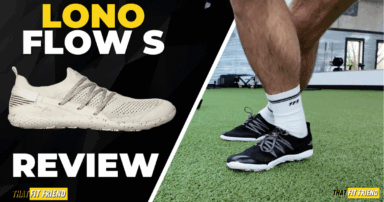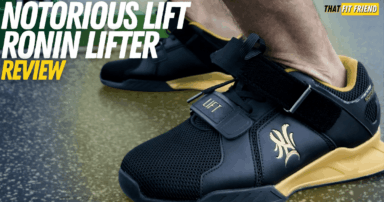That Fit Friend is supported by its readers. I [Jake] run this site myself and buy the gear reviewed. If you purchase through my site, I may earn commissions on sales. Read more here!
The Flux Adapt Runner is the debut running shoe from Flux Footwear. This debut model is designed to have a wider toe box and to account for a wide range of running needs.
As a fan of the Flux High-Top Trainer, I was stoked to buy and put the Flux Adapt Runner to the test. Every week, I run between 6-10 miles for my hybrid workouts and have used the Adapt Runner for just over 100 miles now.
Quick Take: The Flux Adapt Runner is a good “generalist” running shoe and it should work well for casual running and runners wanting a model for walking, short and mid-range runs (1-6 miles), and cross-training.
What’s Good About the Flux Adapt Runner?
After multiple runs and workouts in the Flux Adapt Runner, I’ve found a few things to enjoy with this shoe. To be fair, this shoe did take a week or two to grow on me but I’ve since come to appreciate them.
1. Responsive and Bouncy Midsole
The AdaptFoam midsole provides a nice blend of responsiveness and bounciness when running. This shoe has a “toe off” construction so if you’re a forefoot runner then I think you’ll appreciate this.
I also like that the midsole is a little more dense compared to super thick and lightweight foam midsoles. For those who want a denser feeling midsole then I think you’ll enjoy this.
2. Good Wide Running Shoe for Track Workouts
I love tackling track workouts, where I combine running with bodyweight exercises and circuit-style training. The Adapt Runner worked well for my interval and kettlebell track workouts.
The wider forefoot gives you more room to splay your toes and grip the floor when cross-training, and its poppy midsole feels like it works best for short to mid-range runs, which translates well to interval workouts.
3. Knit Upper Is Great for Hot Climates and Walking
If you’re big on wearing your running shoes for walking and casual wear, then I think you’ll resonate with the AdaptKnit upper in this model. This material stretches and breathes super well in different climates.
I also like the bootie-style construction as it makes this model easy to slip on and off in a casual wear context. For walking and general wear, the Flux Adapt Runner has become one of my go-to running shoes.
What’s Not Good About the Flux Adapt Runner?
While I like the Flux Adapt Runner, for the most part, there are a few things that I think could be improved on with this shoe.
1. Not Great for Those That Need Arch Support
In the Adapt Runner, there’s a break in the rubber at the material’s midfoot. In theory, I like this and see the point of allowing the foot’s arch to do its natural thing when running but I also found it to be problematic at times.
For example, when I get fatigued when running I tend to heel strike and my feet will roll in a little more. In this context, I like having a bit more structure to my shoes to assist with this.
If you’re similar in liking arch support and more structure to your shoe’s midsoles then you may want to consider this or limit the Adapt Runner’s use for particular workouts like I do.
2. Can Feel Heavy At Times
The Adapt Runner is not the lightest running shoe on the market, which cuts into this shoe’s performance for sprints and long-distance runs, especially if you tend to enjoy lighter running shoes like myself.
For longer runs, I’ll reach for my Adidas Adizero Boston 12 over the Adapt Runner due to its being lighter and feeling a little more structured throughout its midsole and upper, for example.
Flux Adapt Runner Performance Overview
Since I view the Flux Adapt Running as a generalist running shoe, I wanted to test them in a variety of settings. For my review, I tested the Adapt Runner for short and mid-range runs, cross-training, and walking and daily wear.
Testing the Flux Adapt Runner for Running
For runs that ranged from 1-6 miles the Adapt Runner has performed well. Each week, I blend interval and pick-up runs with slow-paced 4-6 mile runs to build my engine and this shoe has held up well for these workouts.
In these running contexts, I’m a lot more forefoot and midfoot strike dominant and I feel as though the “toe off” feature in this shoe feeds well into this running style.
I think if you’re similar with your running, then this shoe will resonate with you and feel comfortable for your running needs. I also like that this shoe can be a viable running option for wide feet, which is an area lacking in running shoe space as a whole.
I wasn’t the biggest fan of this shoe for sprints because the knit upper didn’t provide enough security to lock the foot down. Then, on longer runs, I decided to limit my use of this shoe because I didn’t like how my foot interacted with the break in the medial midfoot.
In this shoe, I tried pushing my mileage once in them, and they just didn’t align with my running style, hence why I kept my distances short in these. They may resonate with some, but I don’t love their weight and lack of structure for long-distance runs.
Testing the Flux Adapt Runner for Cross-Training
If you like using your running shoes for light strength training and cross-training the Flux Adapt Running should work fine. This model’s midsole is dense enough to support some loaded movement.
For example, on my full-body hybrid workout days, I like using the Adapt Runner when I have lighter dumbbell lunges and kettlebell swings programmed. It feels a lot more stable compared to other running shoes I’ve used for cross-training.
This is also why I think the Adapt Runner can be a good option for track workouts and for those wanting a running shoe for cross-training that doesn’t have so much toe spring and heel bevelling where it’s impossible to use.
All that said, I wouldn’t recommend lifting heavy in the Adapt Runner and I would cap any barbell lift to about 185-225 lbs as that’s where I started to notice compression.
Testing the Flux Adapt Runner for Walking and Daily Wear
Thus far, I’ve used the Flux Adapt Runner for multiple days, walking anywhere from 4 to 8 miles and keeping them on all day. In every use case, I’ve enjoyed the fit and feel of the Adapt Runner.
From a comfort standpoint, the AdaptKnit does a good job at providing just enough security without squeezing the foot too tight but also giving you enough room to let your feet spread, relax, and move naturally.
I also like that they have a bootie-style construction which makes them easy to slip on and off. I can be lazy with my footwear so this feature is always a nice touch for contexts where I want to slip my shoes on and walk the dog or run errands.
All that said, if you plan on using your Adapt Runner for walking it should work plenty well for your needs and wants. It’s comfortable and wide, and it articulates pretty well, which feeds into its overall comfort.
Buy the Flux Adapt Runner If
- You want a wider running shoe with a zero-drop construction and you’re tired of Altra shoes having durability issues.
- You enjoy running shoes that can double as shoes for walking, light strength training, and cross-training.
- You live in hot climates and like running shoes with lightweight uppers that breathe well.
Don’t Buy the Flux Adapt Runner If
- You want a running shoe primarily sprints and marathon training. I don’t think this shoe is niche enough with its features for that context.
- You need more arch support in your running shoes and often struggle with overpronation when running.
- You like lightweight running shoes that feel like nothing on the feet. These can feel a tad clunky at times.
Flux Adapt Runner Sizing
For the Flux Adapt Runner, I think most runners and athletes should be safe going true to size in this model. The length runs true and with its wide last medium and wide feet should feel fine in this model.
I have an E-width foot and this model feels pretty true without feeling overly loose which I like because I can wear different socks in these without feeling restricted or like I’m sacrificing security.
The only sizing and fit contexts in which I think you’ll want to watch out in this model is if you have narrow feet or need arch support. For narrow feet, I’m not convinced you’ll get enough upper security even if you size down a half-size.
On the topic of arch support, if you find that you need running shoes to combat overpronation that hinders running performance then you may also want to consider opting for a different shoe or trying this one without damaging them in the event you need to return.
- Flux Adapt Runner Sizing Thoughts: True to size for most.
If you have additional Adapt Runner sizing questions, drop them below and let me know what running shoe you currently wear and in what size. With more context, I can help you more thoroughly.
Adapt Runner Construction Specs
The Flux Adapt Runner has a few proprietary materials and features used to give it its unique fit and feel. Below are some construction specs to note with this model.
- Heel-to-Toe Drop: 0mm
- Weight: 12.15 oz (for my size 10)
- Removable Insole: Yes
- AdaptFoam Midsole
- Rubber Outsole
- AdaptKnit Upper
- Bootie-Style Construction
- AdaptSol Insole
- 4 Core Eyelets With a 5th for Lace-Lock
If you have additional questions about the Adapt Runner’s construction, drop a comment below or check out my construction section covering this shoe in the video above.
Final Thoughts
The Flux Adapt Runner should work well for runners with wide feet who need a running shoe for light runs, cross-training, and walking. This model will also work well for runners who love 0mm heel-to-toe drops in their shoes.
While I like the Adapt Runner for the most part, there are a few things that would be cool to see improved in future models. For example, I think increasing the upper security and bringing down this shoe’s weight would make it even more versatile.
If you have additional questions about the Flux Adapt Runner, drop a comment below or reach out to me via Instagram (@jake_boly or @that_fit_friend).























Danni
I measure exactly at a size 7 in womens. Should I be sizing up or staying at the exact measurement of 9 1/4 inches.
I’d go with the 7